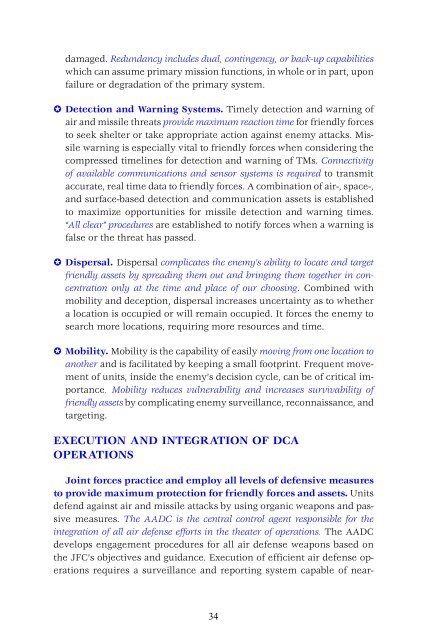Air Force Doctrine Document 2-1.1
Air Force Doctrine Document 2-1.1
Air Force Doctrine Document 2-1.1
Create successful ePaper yourself
Turn your PDF publications into a flip-book with our unique Google optimized e-Paper software.
damaged. Redundancy includes dual, contingency, or back-up capabilities<br />
which can assume primary mission functions, in whole or in part, upon<br />
failure or degradation of the primary system.<br />
❇ Detection and Warning Systems. Timely detection and warning of<br />
air and missile threats provide maximum reaction time for friendly forces<br />
to seek shelter or take appropriate action against enemy attacks. Missile<br />
warning is especially vital to friendly forces when considering the<br />
compressed timelines for detection and warning of TMs. Connectivity<br />
of available communications and sensor systems is required to transmit<br />
accurate, real time data to friendly forces. A combination of air-, space-,<br />
and surface-based detection and communication assets is established<br />
to maximize opportunities for missile detection and warning times.<br />
“All clear” procedures are established to notify forces when a warning is<br />
false or the threat has passed.<br />
❇ Dispersal. Dispersal complicates the enemy’s ability to locate and target<br />
friendly assets by spreading them out and bringing them together in concentration<br />
only at the time and place of our choosing. Combined with<br />
mobility and deception, dispersal increases uncertainty as to whether<br />
a location is occupied or will remain occupied. It forces the enemy to<br />
search more locations, requiring more resources and time.<br />
❇ Mobility. Mobility is the capability of easily moving from one location to<br />
another and is facilitated by keeping a small footprint. Frequent movement<br />
of units, inside the enemy’s decision cycle, can be of critical importance.<br />
Mobility reduces vulnerability and increases survivability of<br />
friendly assets by complicating enemy surveillance, reconnaissance, and<br />
targeting.<br />
EXECUTION AND INTEGRATION OF DCA<br />
OPERATIONS<br />
Joint forces practice and employ all levels of defensive measures<br />
to provide maximum protection for friendly forces and assets. Units<br />
defend against air and missile attacks by using organic weapons and passive<br />
measures. The AADC is the central control agent responsible for the<br />
integration of all air defense efforts in the theater of operations. The AADC<br />
develops engagement procedures for all air defense weapons based on<br />
the JFC’s objectives and guidance. Execution of efficient air defense operations<br />
requires a surveillance and reporting system capable of near-<br />
34
















